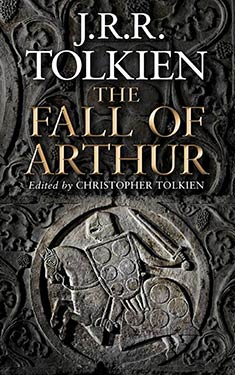JRR Tolkien
Completed 9/13/2015, Reviewed 9/15/2015
3 stars
How do you review an unfinished poem in Old English style
alliterative verse that’s about 45 pages long with 180 pages of
commentary? Carefully? This is one of a group of books of
alliterative verse that Tolkien never finished which his son published
posthumously. It’s about the last tragic
scenes from King Arthur’s life, with Mordred usurping the crown and pursuing
Guinevere, the exile of Lancelot, and the death of Arthur. It’s told in alliterative verse, so it’s a
tough read. I chose this book because I
thought it would be a break from Middle-Earth and an introduction to the
alliterative verse style I will encountering in the next book in the History of
Middle Earth series. I’m glad I chose
this over his longer poems. It was just
the right amount to be overwhelmed.
 Alliterative verse means that several words in a line begin
with the same sound, like the T’s in “Attend the Tale of Sweeny Todd”. It was a common form of poetry used in Old
and Middle English. This being my first
encounter with it, I found myself often becoming fixated on the alliteration
rather than the content. Add this to my
already mediocre appreciation of poetry, and you can probably guess that I had
to reread many verses to get what was going on.
It took a while, but I was able to appreciate the musicality of the
poetry.
Alliterative verse means that several words in a line begin
with the same sound, like the T’s in “Attend the Tale of Sweeny Todd”. It was a common form of poetry used in Old
and Middle English. This being my first
encounter with it, I found myself often becoming fixated on the alliteration
rather than the content. Add this to my
already mediocre appreciation of poetry, and you can probably guess that I had
to reread many verses to get what was going on.
It took a while, but I was able to appreciate the musicality of the
poetry.
The commentary was difficult to follow. I think one needs to be quite the bibliophile
or at least have been an English major to appreciate the analysis that
Christopher produced. The one chapter
compared the poem to other Arthur texts.
I found this quite confusing, only having read “The Once and Future King”
in high school; my memory of the Arthur myth is very minimal. The texts Christopher discussed were some of
the earliest documents describing the Arthur myth. I know it’s probably great analysis, but the
bouncing between which text had what detail of the myth lost me.
Another chapter discussed the influence of the Arthur myth on
the development of the Silmarillion, particularly Avalon, Numenor, and
Atlantis. The third discussed the evolution of the poem from earlier drafts and
notes. In both of these, the concepts
are interesting and I could follow part of the discussion, but eventually, my
eyes would glaze over and I’d be lost.
I give this book three stars out of five. It might be a brilliant book from the
academic perspective, but that’s out of my realm. I’d recommend reading the poem though because
it is an experience. Tolkien was quite
the wordsmith. Despite my lack of
academic prowess in literary analysis, I’ll continue to read Tolkien’s
posthumous works. I’m hoping that by the time I get to the last of his works,
I’ll be able to appreciate, if not understand, the sorts of things Christopher
presents in these tomes.
No comments:
Post a Comment